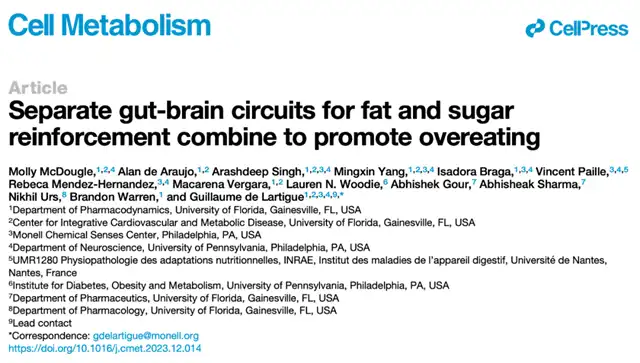Why Do People Love Unhealthy Junk Food?
- Normal Liver Cells Found to Promote Cancer Metastasis to the Liver
- Nearly 80% Complete Remission: Breakthrough in ADC Anti-Tumor Treatment
- Vaccination Against Common Diseases May Prevent Dementia!
- New Alzheimer’s Disease (AD) Diagnosis and Staging Criteria
- Breakthrough in Alzheimer’s Disease: New Nasal Spray Halts Cognitive Decline by Targeting Toxic Protein
- Can the Tap Water at the Paris Olympics be Drunk Directly?
Why Do People Love Unhealthy Junk Food?
- Should China be held legally responsible for the US’s $18 trillion COVID losses?
- CT Radiation Exposure Linked to Blood Cancer in Children and Adolescents
- FDA has mandated a top-level black box warning for all marketed CAR-T therapies
- Can people with high blood pressure eat peanuts?
- What is the difference between dopamine and dobutamine?
- How long can the patient live after heart stent surgery?
Why Do People Love Unhealthy Junk Food? Sugar and Fat Activate Gut-Brain Circuits Triggering Binge Eating…
The rapid increase in global obesity rates has been attributed to changes in the food environment that promote excessive consumption of high-calorie foods rich in fat and sugar. However, the mystery of why we have a preference for such unhealthy high-calorie diets persists. While we understand that food has a powerful influence on our choices, the precise neural circuits in the brain behind this phenomenon remain unclear.
On January 18, 2024, researchers from the University of Florida published a study titled “Separate gut-brain circuits for fat and sugar reinforcement combine to promote overeating” in the journal Cell Metabolism.
The study revealed that neural cells in the gut drive our preference for high-fat and high-sugar diets. Fat and sugar recruit distinct gut-brain neural pathways, inducing the release of dopamine in the brain’s reward center. Combining fat and sugar, such as in chocolates or doughnuts, further synergizes these independent neural pathways, promoting additional dopamine release and leading to binge eating.

This research suggests that our intake of high-sugar and high-fat diets stems from a subconscious desire, explaining why we find it challenging to resist unhealthy foods with high sugar and fat content. It also hints at the possibility that targeting and regulating the gut-brain reward circuits could be a novel approach to curb unhealthy eating habits, providing new insights for future developments in anti-obesity strategies and treatments.
Food is a powerful natural reinforcer that guides eating decisions. However, the specific appeal of fat and sugar has long been a mystery. The vagus nerve transmits internal sensory information about nutritional value from the gut to the brain, but our understanding of the cellular and molecular basis of specific macronutrient reward circuits is limited.
In this study, the research team provided direct evidence for independent vagus nerve sensory pathways for fat and sugar by monitoring intracellular calcium dynamics. They identified two specialized vagus nerve pathways: one for fat and another for sugar. These neural circuits, originating in the gut, convey information about what we eat to the brain, laying the foundation for appetite. Both types of neurons lead to the release of dopamine in the reward center of the mouse brain.
The research further found that fat and sugar are sensed by discrete neurons of the vagus nerve, activating parallel but distinct reward circuits to control nutrient-specific reinforcement. Activating both fat and sugar neural pathways simultaneously produces a powerful synergistic effect. The research team stated that it’s like delivering a “double blow” to the brain’s reward system. Even with the total calorie content remaining constant in fat and sugar, combining them results in significantly more dopamine release, ultimately causing mice to overeat.
The team suggested that communication between our gut and brain occurs below the level of consciousness, explaining why we crave these high-fat, high-sugar diets without being aware of it. This also highlights the difficulty in resisting such diets consciously, suggesting that the human brain may be subtly reprogrammed to seek combinations of high-fat and high-sugar foods, regardless of our conscious resistance.
In a cartoon provided by the research team, sugar, fat, and their combination (chocolate) navigate the gut-brain maze. The blue path represents the sugar route, the green path represents the fat route, and the yellow path represents the combined impact of fat and sugar. Each path leads to the brain, but the path of the fat-sugar combination has a greater impact, triggering the release of dopamine in the reward circuit and emphasizing the synergistic effect of the fat-sugar combination on neural responses.
The researchers predict that this study provides new directions for the future development of anti-obesity strategies and treatments. Targeting and regulating the gut-brain reward circuits may offer a new approach to restrain unhealthy eating habits.
Why Do People Love Unhealthy Junk Food?
(source:internet, reference only)
Disclaimer of medicaltrend.org
Important Note: The information provided is for informational purposes only and should not be considered as medical advice.



